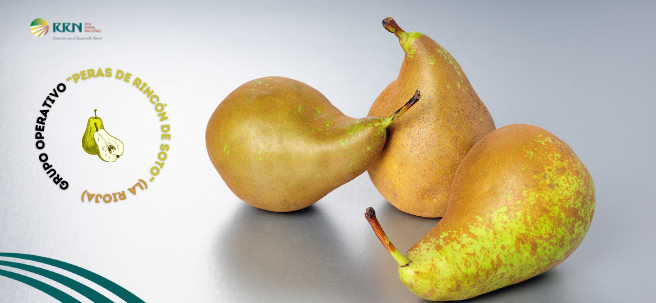
16 de June de 2021
June 16, 2021. The Conference pear market in La Rioja ranks third in economic value in the Riojan agri-food sector, behind only the wine industry and mushrooms.
- The “Pears of Rincón de Soto” Operational Group (La Rioja) was created in 2017 with the aim of avoiding production losses in this crop.
- The Rincón de Soto Conference pear is ascribed to a Protected Designation of Origin
Currently, the area under this crop exceeds 2,500 hectares , with an annual production of approximately 30,000 tons . In the sweet fruit subsector, the Conference pear is the only product that has increased its cultivation area in the last two decades, thanks to a conversion of traditional varieties to the Conference pear, which now accounts for 80% of total pear production in La Rioja.
The creation of an innovation project—through the Operational Group —to improve the production of this crop that brings so much joy to the Riojan countryside is therefore not trivial. In fact, the Operational Group's research has focused on preventing production losses caused by the development of internal disorders in the fruit itself, which was a constant variable in Conference pear cultivation.
Goals
The project was created to study the nutritional, mineralogical, and storage behavior of Conference pears from the Rincón de Soto Protected Designation of Origin (PDO) . To this end, the group has developed a comprehensive control system that allows for the monitoring of these changes. The idea is to optimize fruit harvesting, control, and storage protocols through a procedure based on:
1.- Definition of a new maturity index in the harvest that is representative
2.- Development of systems for predicting internal disorders
3.- Review and optimization of the conservation strategy
To carry out this process, the pears are stored in cold storage , observing the fruits as they leave the chambers and analyzing their mineral composition.
At the end of the innovation project, the Operational Group will have developed a comprehensive control strategy in successive campaigns, and it will be possible to determine the benefits of the new system from a product marketing perspective. This will allow commercial validation trials of the standard optimized control system to also be applied in collaborating companies.
Results
Following its creation in 2017, the "Peras de Rincón de Soto" Operational Group will soon present the results of its research as the closing of the innovation project.
Sixto Cabezón Largas, general director of the Regulatory Council of the Rincón de Soto Pears PDO and project coordinator, presents the main conclusions of the work carried out to the RRN:
- The average mineral composition of pears from La Rioja has been determined. This has allowed us to determine the causal relationship between iron (Fe), calcium (Ca), phosphorus (P), and nitrogen (N) content and the likelihood of internal alterations during storage.
- The method of evolution of internal starch degradation has been identified as the ideal factor to determine the time of harvest .
- A guide has been published with protocols for field monitoring, harvesting, and storage of fruit, providing an integrated system of best practices and advice.
In Sixto's words, "the objectives have been more than met, validating new, simple and reliable ripening control systems, establishing guidelines to follow at all times (from production to long-term storage), and shedding light on the problem of internal browning, helping us better understand some of its variables."











